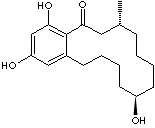PRODUCT IDENTIFICATION

H.S.CODE
TOXICITY
c12c(c(cc(c1)O)O)C(O[C@H](CCC[C@@H](CCCCC2)O)C)=O
CLASSIFICATION
Anabolic, Non-steroidal estrogen
EXTRA NOTES
PHYSICAL AND CHEMICAL PROPERTIES
AUTOIGNITION
NFPA RATINGS
REFRACTIVE INDEX
EXTERNAL LINKS & GENERAL DESCRIPTION
Drug Information Portal (U.S. National Library of Medicine) - Zeranol
PubChem Compound Summary - Zeranol
IPCS INCHEM - Zeranol
Drug Bank - Zeranol
KEGG (Kyoto Encyclopedia of Genes and Genomes) - Zeranol
http://www.ebi.ac.uk/ - Zeranol
http://www.ncbi.nlm.nih.gov/ - Zeranol
http://www.breastcancerfund.org/Zearalenone and its synthetic derivative zeranol (Ralgro) are estrogenic compounds to which cattle and swine in the U.S. meat industry are extensively exposed. Natural sources of zearalenone come from contamination of feed sources, including corn silage and hay, by the fungus Fusarium, which is an active producer of the chemical (Benzoni, 2008; Mirocha, 1979). Contamination of food by zearalenone and its natural metabolites (breakdown products) has been associated with the development of precocious puberty-a known risk factor for breast cancer-in young girls (Massart, 2008). These compounds have also been shown to enhance proliferation of ER+ human breast tumor cells in vitro through estrogen-mediated pathways and activation of gene profiles similar to those activated by the natural hormone estradiol (Khosrokhavar, 2009; Parveen, 2009).
Local:
Zeranol is a non-steroidal estrogenic growth stimulant that is used in
veterinary medicine and has been used for human. The use for growth promotion in
food animals was banned in the EU. An anabolic-estrogenic agent promote cell
growth and division, resulting in growth of muscle tissue and sometimes bone
size and strength. Testosterone and androgen are examples. Zeranol is also
called zearalenol as it is a reduction product of zearalenone, an estrogenic
mycotoxin product. Oestradiol-17beta, testosterone, progesterone, and trebolne
are also used as growth stimulants for food animals.
Non-steroidal estrogen analog |
CAS RN |
| Equol | 531-95-3 |
| 2-sec-Butylphenol | 89-72-5 |
| Diethylstilbestrol | 56-53-1 |
| Bisphenol A | 80-05-7 |
| Dienestrol | 84-17-3 |
| Coumestrol | 479-13-0 |
| Allenolic acid | 553-39-9 |
| Chlorotrianisene | 569-57-3 |
| 4-Octylphenol | 1806-26-4 |
| Hexestrol | 5635-50-7 |
| Zearalenone | 17924-92-4 |
| Zeranol | 26538-44-3 |
APPEARANCE
97.0% min
MELTING POINT
178 - 185 C
OPTICAL ROTATION
+44.5° ~ +47.5°
LOSS ON DRYING
0.5% max
RESIDUE ON IGNITION
0.1% max
beta-ZERABOL
1.5% max
HAZARD OVERVIEW
OSHA Hazards:Target Organ Effect, Irritant, Teratogen, Reproductive hazard. Target Organs: Reproductive system.
GHS
PICTOGRAMS


HAZARD STATEMENTS
H315-H319-H335-H360
P STATEMENTS
P201-P261-P305 + P351 + P338-P308 + P313
![]()
RISK PHRASES
60-36/37/38
SAFETY PHRASES
53-36/37/39-45